Atlantic sailfish - West Atlantic|
| Fact Sheet Title Fact Sheet |
| | | Atlantic sailfish - West Atlantic |
| | Data Ownership | | This document owned by International Commission for the Conservation of Atlantic Tunas (ICCAT), provided and maintained by Standing Committee on Research and Statistics , is part of ICCAT SCRS Reports data collection. |
| | ident Block | ident Block | | | | Species List: | | Species Ref: en - Atlantic sailfish, fr - Voilier de l'Atlantique, es - Pez vela del Atlántico, ru - Парусник атлантический |
|
|
| ident Block Atlantic sailfish - West Atlantic
Map tips
- Click on
 to turn layers on and off to turn layers on and off
- Double-click to zoom in
- Drag to pan
- Hold down the shift key and drag to zoom to a particular region
| iccat Smu |
|---|
| SAI_W | West Atlantic |
|---|
|
|
|
|
| | Aq Res | Biological Stock: No
Value: Sub-Regional
Management unit: Yes
Reference year: 2014
|
| Considered a management unit: An aquatic resource or fishery is
declared as [Fishery] Management Unit if it is
effectively the focus for the application of selected
management methods and measures, within the broader
framework of a management system. According to the FAO
Glossary for Responsible Fishing, "a Fishery Management
Unit (FMU) is a fishery or a portion of a fishery
identified in a Fishery Management Plan (FMP) relevant
to the FMP's management objectives." FMU's may be
organised around fisheries biological, geographic,
economic, technical, social or ecological dimensions ,
and the makeup and attribute of a fishery management
unit depends mainly on the FMP's management
objectives. |
| Jurisdictional distribution: Jurisdictional qualifier (e.g.
"shared", "shared - highly migratory") of the aquatic
resource related with its spatial distribution. |
| Environmental group: Classification of the aquatic
resource according to the environmental group (e.g.
pelagic invertebrate, or demersal fish) to which the
species belong. |
| Reference Year: The Reference Year is the last year considered in the stock assessment and/or fishery status. |
| | | | | | History The most recent stock assessments for East and West sailfish were conducted in 2016 using catch data available to 2014, through a process that included meetings for data preparatory, and a catch rate standardization workshop in May. The previous sailfish stock assessments were conducted in 2009. Habitat Bio Climatic Zone: Temperate. Horizontal Dist: Oceanic. Vertical Dist: Pelagic. Sailfish is more coastally oriented than other billfish species. Conventional tagging data suggests they move shorter distances than the other billfish (Figure 1). Temperature preferences for adult sailfish appear to be in the range of 25-28°C. Sailfish generally seek out the warmest water available, and electronic tagging studies indicate that about 96% of darkness, 86% of twilight, and 82% of daylight hours are spent near the surface (Hoolihan et al. 2011). Vertical habitat use is more complex however, with frequent short duration excursions to deeper depths in excess of 100 m, with some dives as deep as 350 m. Sailfish grow rapidly and reach a maximum size of 160 cm for males and 220 cm for females, with a mean maximum age of at least 12 years. A new length at 50% maturity (L50) has been estimated for West Atlantic female sailfish (146.12 cm LJFL); while the previous L50 value used for western sailfish males remains at 135.7 cm LJFL. No values are currently available for eastern Atlantic sailfish. Sailfish spawn over a wide area and year around. For the western stock, evidence of spawning has been detected in the Straits of Florida, and off the Venezuelan, Guyanese and Surinamese coasts. In the southwestern Atlantic, spawning has been confirmed off the southern coast of Brazil between 20° and 27°S. Additional spawning areas occur in the eastern Atlantic off Senegal and Côte d’Ivoire. Timing of spawning can differ between regions; from the Florida Straits to the areas off Guyana western Atlantic sailfish spawn in the second and third quarter of the year, while in the southwestern Atlantic they spawn during the austral summer. 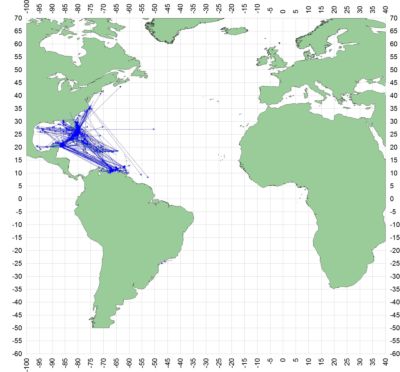 | Figure 1. Conventional tag returns for Atlantic sailfish. Lines join the locations of release and recapture.  |
Geo Dist Geo Dist: Highly migratory Sailfish ( Istiophorus albicans) has a pan-tropical distribution. Water Area Overview Spatial Scale: Sub-Regional Water Area Overview  | | Water Area Overview Atlantic sailfish - West Atlantic
| iccat Smu | SAI_W: West Atlantic |
| | | | | | Water Area Overview |
Water Area OverviewAtlantic sailfish - West Atlantic Aq Res Struct Biological Stock: No Based on life history information, migration rates and geographic distribution of catch, ICCAT has established two management units for sailfish, eastern and western Atlantic stocks (Figure 2). However, a recent preliminary study investigating genetic differentiation among groups of Atlantic sailfish suggests genetic stock structure between both the eastern and western Atlantic, and northern and southern hemispheres, suggesting the need for further investigations to elucidate and confirm the presence of additional stock structure that may influence future assessments. 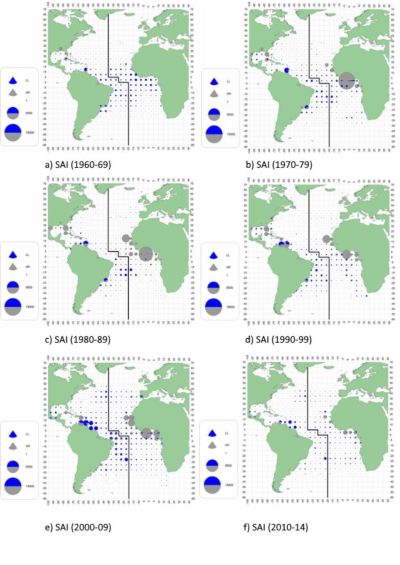 | Figure 2. Geographic distribution of sailfish total catches by decade (last decade only covers 5 years). The dark line denotes the separation between stocks.  |
Exploit Description of fisheriesSailfish are targeted by coastal artisanal and recreational fleets and are captured to a lesser extent as by-catch in longline and purse seine fisheries. Historically, catches of sailfish were reported together with spearfish by many longline fleets. In 2009 these catches were separated by the Committee ( Table 1). The western stock is exploited by longline, recreational fisheries, and by surface fisheries, mainly artisanal drift-gillnet. The main longline fleets include Brazil, EU-Spain, Venezuela and Grenada, which operate in the western and central Atlantic. The main surface fisheries are carried out by the artisanal fleets of Grenada and Venezuela in the Caribbean Sea and waters of the tropical western Atlantic. Total reported landings steadily increased since 1960 to peak 2,098 t in 2002 (Figure 3). A steep decreasing trend of catch is observed from 2005, mainly due to a decreased catch by the surface (artisanal drift-gillnet) fisheries. The total catch in 2015 was 892 t, and the average catch in the last five years was about 1,083 t, below the historical average of 1,584 t recorded in 1991-2009, after the inclusion of the artisanal fisheries. Although there has been some progress, historical catches of unclassified billfish continue to be reported to the Committee, confounding sailfish catch estimates. Catch reports from countries that have historically been known to land sailfish continue to suffer from gaps and there is increasing ad hoc evidence of unreported landings in some other countries. These considerations provide support to the idea that the historical catch of sailfish has been under-reported, especially in recent times where more and more fleets encounter sailfish as by-catch or direct targeting. 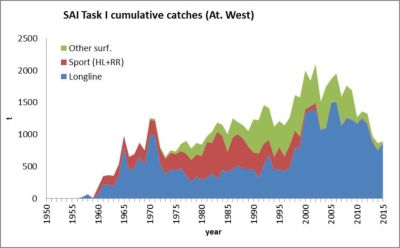 | Figure 3. Task I catches of sailfish for the West Atlantic stock.  |
Bio Assess Assess Models Several standardized CPUE data series were used in 2016 for the Atlantic sailfish stock assessment. for the western Atlantic stock, the eleven indices used were: Brazilian longline, Brazilian rod & reel, Chinese Taipei longline, Japanese longline (early and late), EU-Spain longline, US longline observer, US rod & reel, Venezuelan longline, Venezuelan rod & reel, and Venezuelan artisanal (Figure 4). For both stocks, the available CPUE time series showed a mixture of both decreasing and increasing trends, which demonstrated a potential conflict in the indicators of stock abundance. For this reason, CPUE time series were put into two groups, each based on the similarity of their indication of stock abundance (i.e., increasing or decreasing). In the assessment, these CPUE groups were considered as alternatives for the surplus production and Stock Synthesis models. 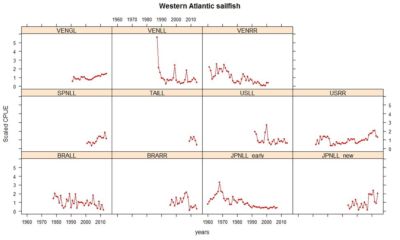 | Figure 4. Relative abundance indices used in the assessment of the western Atlantic sailfish stocks. All indices were scaled to the mean of each series prior to graphing.  |
Important progress was made on the integration of new data sources, in particular standardized catch rate data, size data, and modeling approaches, in the 2016 assessment of the status of the stocks of Atlantic sailfish. For both stocks (East and West), uncertainty in data inputs and model configuration was explored through sensitivity analysis. They revealed that results were sensitive to structural assumptions of the models. The production model formulations and the Stock Synthesis model (applied for the western stock) had varying degrees of difficulty fitting the decreasing or increasing trends in the CPUE series. Overall, assessment results were uncertain and should be interpreted with caution. The ASPIC and the Bayesian surplus production models examined were heavily influenced by the priors used in the models. Neither model could provide stock status due to the large uncertainty in benchmark estimates, and generally poor model convergence. The point estimates of both Stock Synthesis models indicated that the stock is neither overfished nor experiencing overfishing (Figure 5). In contrast, the Stock Reduction Analysis model indicated that the stock was overfished with overfishing occurring (0.23-0.61 BMSY; 0.69-2.45 FMSY). However, due to the large degree of uncertainty in the Stock Reduction Analysis results, the Stock Synthesis models were used for management recommendations. 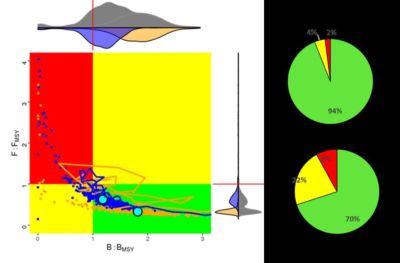 | Figure 5. Kobe plot (left) summarizing stock status of Sailfish_west based on Stock Synthesis models with increasing CPUE trends (Model 1) and with decreasing CPUE trends (Model 2). The estimated trajectories and uncertainty points for Model 1 are shown in golden yellow, and in blue for Model 2. The marginal densities plots for stock relative to BMSY and harvest rate relative to FMSY are also shown (top and right of large panel); the upper part (grey) are combined probabilities for both Stock Synthesis models, and the lower part (colored) are individual probabilities of Model 1 and Model 2. The red lines represent the benchmark levels (ratios equal to 1.0). Pie charts showing summary of current stock status estimates for the Sailfish_west stock based on Stock Synthesis models.  |
Results Projection OutlookThe eastern and western sailfish stocks may have been reduced to stock sizes below BMSY. There is considerable uncertainty on the level of reduction. The results for the eastern stock were more pessimistic than those for the western stock in that more of the results indicated recent stock biomass below BMSY. Therefore, there is particular concern over the outlook for the eastern stock. Due to the difficulty of determining current status for both the eastern and western Atlantic stocks, the Committee considered that it was not appropriate to conduct quantitative projections of future stock condition based on the range of scenarios considered at the stock assessment meeting Management Management unit: Yes Effects of current regulationsNo ICCAT regulations for sailfish are in effect, however, some countries have established domestic regulations to limit the catch of sailfish. Among these regulations are: requirement of releasing all billfish from longline vessels, minimum size restrictions, use of circle hooks and catch and release strategies in sport fisheries. Currently, four ICCAT Contracting Parties (Brazil, Canada, Mexico, and the United States) mandate or encourage the use of circle hooks on their pelagic longline fleets. Recent research has demonstrated that in some longline fisheries the use of non-offset circle hooks resulted in a reduction of billfish mortality, while the catch rates of several of the target species remained the same or were greater than the catch rates observed with the use of conventional J hooks or offset circle hooks. Advice Considerable uncertainty still remains in the assessments of both the eastern and western stocks. Available abundance indices demonstrate conflicting trends for both stocks, and there are concerns that reported catches, including dead discards, may be incomplete. Nevertheless, it should be noted that there have been significant improvements since the last assessment. There were more abundance indices available, and the standardizations have seen general improvement, fostered in part by the CPUE workshop held in advance of this meeting. As was the case during the 2009 Sailfish Stock Assessment Session, the results for the eastern stock were more pessimistic than the western stock in that more of the results indicated recent stock biomass below BMSY. The Stock Synthesis models for the western Atlantic sailfish stock estimates MSY between 1,438-1,636 t. Although current catches are well below this level, the results of the assessment were highly uncertain, and therefore the Committee recommends that the western Atlantic sailfish catches should not exceed current levels.
| WESTERN ATLANTIC SAILFISH SUMMARY |
| Maximum Sustainable Yield (MSY) |
1,438-1,636 t 1,2 |
| Current Yield (2015) |
892 t |
| B2014/BMSY |
1.81 (0.51-2.57)1
1.16 (0.18-1.69)2
|
| F2014/FMSY |
0.33 (0.25 – 0.57)1
0.63 (0.42 – 2.02)2
|
| Overfished |
Not likely |
| Overfishing |
Not likely |
| Management Measures in Effect |
None |
1 Stock Synthesis estimate utilizing increasing CPUE trends, with approximate 95% confidence intervals. 2 Stock Synthesis estimate utilizing decreasing CPUE trends, estimate with approximate 95% confidence intervals. Sources Standing Committee on Research and Statistics (SCRS). “Atlantic Sailfish, Executive Summary.” Madrid, Spain October 3 - 7 2016. ICCAT  http://www.iccat.int/Documents/Meetings/Docs/2016_SCRS_ENG.pdf http://www.iccat.int/Documents/Meetings/Docs/2016_SCRS_ENG.pdf |
|
| |
|
|





